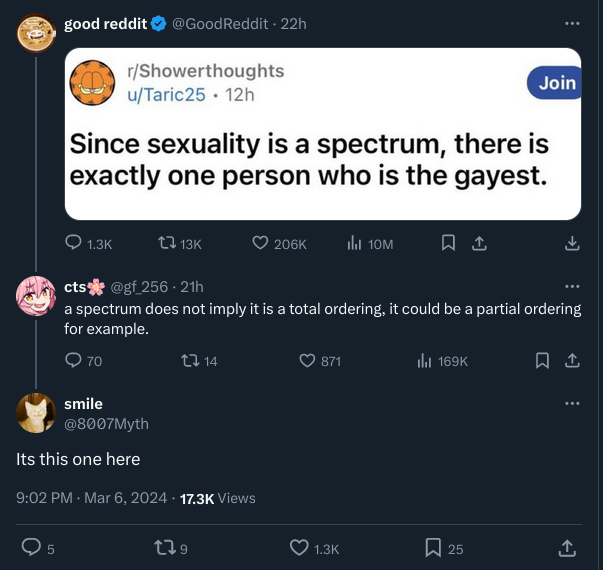this post was submitted on 27 May 2024
967 points (100.0% liked)
196
16845 readers
2593 users here now
Be sure to follow the rule before you head out.
Rule: You must post before you leave.
founded 2 years ago
MODERATORS
you are viewing a single comment's thread
view the rest of the comments
view the rest of the comments

Yeah, I'm really out of my element talking about these abstract mathematical topics... I'm too much of an empirical scientist it seems!
Give me a set and I'll find a way to measure it! ...actually I'd like to know what's the mathematical definition of measurement, there's probably a trick there... 🤔
"Measure" is meant in the specific sense of measure theory. The prototypical example is the Lebesgue measure, which generalizes the intuitive definition of length, area, volume, etc. to N-dimensional space.
As a pseudo definition, we may assume:
The measure of a rectangle is its length times its width.
The measure of the disjoint union of two sets is the sum of their measures.
In 2), we can relax the assumption that the two sets are disjoint slightly, as long as the overlap is small (e.g. two rectangles overlapping on an edge). This suggests a definition for the measure of any set: cover it with rectangles and sum their areas. For most sets, the cover will not be exact, i.e. some rectangles will lie partially outside the set, but these inexact covers can always be refined by subdividing the overhanging rectangles. The (Lebesgue) measure of a set is then defined as the greatest lower bound of all possible such approximations by rectangles.
There are 2 edge cases that quickly arise with this definition. One is the case of zero measure: naturally, a finite set of points has measure zero, since you can cover each point with a rectangle of arbitrarily small area, hence the greatest lower bound is 0. One can cover any countably infinite set with rectangles of area epsilon/n^(2) so that the sum can be made arbitrarily small, too. Even less intuitively, an uncountably infinite and topologically dense set of points can have measure 0 too, e.g. the Cantor set.
The other edge case is the unmeasurable set. Above, I mentioned a subdivision process and defined the measure as the limit of that process. I took for granted that the limit exists. Indeed, it is hard to imagine otherwise, and that is precisely because under reasonably intuitive axioms (ZF + dependent choice) it is consistent to assume the limit always exists. If you take the full axiom of choice, you may "construct" a counterexample, e.g. the Vitali set. The necessity of the axiom of choice in defining this set ensures that it is difficult to gain any geometric intuition about it. Suffice it to say that the set is both too "substantial" to have measure 0, yet too "fragmented" to have any positive measure, and is therefore not well behaved enough to have a measure at all.
Well that's interesting: in order to define unmeasurable sets, you relied on the axiom of choice... I suppose it might be possible to define unmeasurable sets without AC, but maybe not!
Every time I encounter the axiom of choice implying a bunch of crazy stuff, it always loop back to requiring AC. It's like a bunch of evidence against AC!
I find it interesting that the basic description of AC sounds very plausible, but I'm still convinced mathematicians might have made the wrong choice... (See what i did there? 😄)
It's required, but nontrivially so. It has been proven that ZF + dependent choice is consistent with the assumption that all sets of reals are Lebesgue measurable.